
2021 Ironman Chattanooga
Training Cycle
Up until this race, 2021 had been a challenging year from the perspective of peaking for races. Overall, my training this year has been good, but I had experienced niggling injuries just prior to both of my earlier races at Ironman 70.3 Chattanooga and Ironman 70.3 Musselman. It was somewhat of a relief therefore, that my peak build to this race went off without a hitch.
My build to the race included my biggest ever block of training. After a week to recover from Ironman 70.3 Musselman, I averaged 15.75 hours of training per week, up until I started to taper for Ironman Chattanooga. I averaged 4.6 miles of swimming, 145 miles of cycling and 28.5 miles of running per week. These are big numbers, but certainly not as big as many Ironman training plans prescribe. It is all about minimum effective dose, and the fact that I never felt completely shelled by training, tells me that it was an excellent block.
My taper period was fairly typical, although I think it took me until a day or two before the race to completely shed all the fatigue. It wasn’t until I did a shakeout run, when I arrived in Chattanooga on the Thursday of race week, that I felt good.
The bottom line was that I entered race week feeling like I was fully prepared to have a great day on the Sunday. All I needed to do was focus on good rest, hydration and nutrition and I was all set.
Pre-Race
My wife and I left Pittsburgh and drove to Chattanooga on the Thursday of race week. It is about a ten-hour drive, and this makes for a long day. We arrived in town at about 6.30pm and I immediately went for a shakeout run to loosen up my legs. We were staying at a hotel downtown, so I ran down to look at the Ironman village. The village was all closed for the evening, but it was still exciting to see it and the partially constructed finish line. I finished my brief workout by running the first part of the run course. This was a great reminder of the length and steepness of that first hill coming out of transition.
On the Friday morning, I met up with a group of teammates early and we all checked into the race. Most of us then went out to the Chickamauga Dam Day Use Area for a quick open water swim practice. The main topic of conversation was about the possibility of the swim being wetsuit legal. Most of us were convinced we would be wearing wetsuits, even though that is not typical for this race. The water temperature had been measured at 74’F by Ironman earlier that day and the weather wasn’t hot enough to make raising the water temperature a foregone conclusion. I wore my wetsuit for the swim practice and had a really good, if brief session.
The rest of Friday was spent hanging out with friends and teammates at the C26 Triathlon Hub. I recorded a podcast about the race with Coach Mike Tarrolly. You can listen to it here. Later that evening, I had a great dinner with one of my coached athletes, before heading back to the hotel for an early night.
Saturday was bike and bag check-in day. Before dropping off my bike however, I did my usual 20-minute pre-race bike check ride. A whole group of teammates and I rode the first few miles of the bike course out of transition. I dropped in a few accelerations to really test that the bike was functioning correctly… it was. I racked my bike late morning, dropped off my bike and run transition bags and then went back to the hotel. My time for socializing was over. It was time to rest and get ready to race the next day.
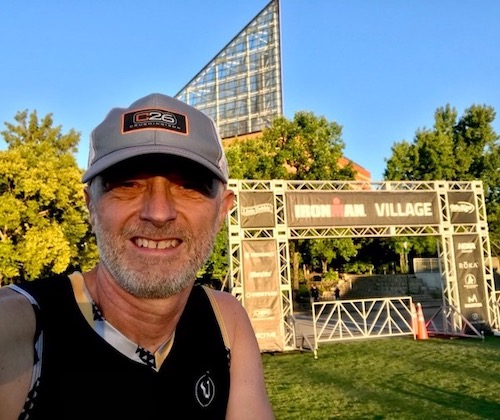
The Race
Race Morning
I woke up just before 4.00am, having had a reasonable night’s sleep. I got up and followed my well-established race morning routine. Breakfast of a bagel and apple sauce, two cups of coffee and then dressing in my one-piece Wattie Ink race kit.
At 5.00am, I met up with some teammates in the lobby of our hotel and we all walked down to transition together. It was still dark but there was excitement in the air, as a couple of thousand athletes prepared for their big day. As I got to my bike, I heard confirmation that the swim was going to be wetsuit legal. I had prepared all summer, for a non-wetsuit legal swim, so this was a big bonus for me. The news reduced my anxiety somewhat and made me even more excited to race.
Having set up my bike, I found my teammates again and we boarded the school bus shuttle to the swim start. We got there nice and early, which left time for a bathroom break and last-minute conversations. Gradually, people started to filter towards the actual start line, as I headed for one last trip to the bathroom. I then went alone to the swim start and put on my wetsuit. I like to be alone at the start. It helps me gather my thoughts and get ready to jump into the water. The playing of the national anthem came and went, then the cannon fired to start the professional races and before I knew it, I was on the pontoon, ready to jump into the water.
The Swim
Prior to entering the water, I took a long look down the Tennessee River at the course. I could see the buoys stretching away into the distance and on their right a line of kayakers as support. It appeared to me that the kayak line took a straighter path to the bend in the river. This, together with the fact that the kayakers seemed to be closer to the middle of the river, convinced me that I should sight off the kayaks, for my swim line. So that is what I did.
The first five minutes of the swim are critical to my race. I need to make sure that I stay calm and keep my breathing under control. I had no anxiety at all and from the time it took me to reach the first kayak, I knew we had a decent current helping us. Breathing to my left, I could see that the vast majority of swimmers were staying close to the buoys. Out by the kayaks, I had clear water. In fact, I don’t remember having any physical contact with another swimmer at all.
I found myself really enjoying the swim and decided that I would try to pick up my pace a little. My thinking was to push hard for a minute or two, then relax for a while to keep my breathing under control and then push again. This worked well. I could see other swimmers and challenged myself to pass them. I managed to pass quite a few along the way.
As I approached the bend in the river, I could feel the current pushing me left towards the main swim pack, so I had to sight more regularly to keep my line. The first orange buoy, indicating I was halfway done, came and went. Then it was the swim under the bridges. Under one of the bridges, I swam close to a rescue boat. This was a mistake because I found myself breathing in diesel exhaust fumes. It was quite nauseating.
Once under the pedestrian bridge, I could see the swim exit and the final buoy, which was red. It was now time to change direction and head straight to the exit. This brought me closer to lots of other swimmers, but I still was able to avoid contact. The exit was soon right there. I grabbed the arm of a volunteer and pulled myself onto the steps out of the water. I smiled. I knew that I had just completed the best swim of my short triathlon career.
Swim Time : 0:58:17
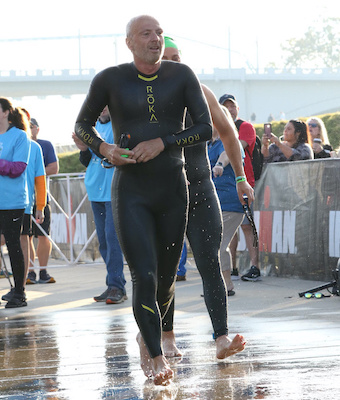
T1
As I climbed the first step getting out of the water, I felt a slight pain in the gracilis muscle of my right leg. This is the adductor muscle that runs down my inner thigh. It spasmed and felt like it might cramp. As I ran away from the river, the pain went away.
I peeled my wetsuit to my waist and ran quickly towards transition. I saw my coach and he yelled ‘we will take that!’. That confirmed to me that my swim was a good one. A little further towards transition, I saw my wife. She too was really happy. My day had started well.
Having grabbed by gear bag, I ran into the change tent and preceded to remove my wetsuit. Again, I felt a twinge in the muscles of my right leg. This got me a little more worried, but I set aside those thoughts and quickly got into my bike gear. I gave my gear bag to a volunteer, ran to my bike and headed out of transition to the bike mount line.
T1 Time : 0:07:46
The Bike
A couple of friends were volunteering at the bike exit, so it was good to see their smiling faces as I got onto my bike. As I headed away from transition, I reminded myself to ease into the ride and not go too hard during the early part of the ride.
The road surface for first five miles or so of the course leaving town is quite rough. This helped me keep my effort under control but also had me concerned about losing a nutrition bottle. I was glad that I had secured my bottles with elasticated bands, because I saw lots of bottles on the road, especially near the railroad tracks we crossed.
After those initial miles, the course crosses into Georgia. Immediately, the quality of the road surface improved dramatically. The surface of Highway 193 was beautifully smooth, asphalt. It was here that I decided I would pick up my effort a little and start working close to my target power for the race. I was able to hit my target power and not feel like I was ‘pushing it’ at all. This was very encouraging. My mind started to think that a great bike split was a possibility.
A few miles later however, I started to feel my adductor muscles starting to spasm. I was now faced with a choice; continue with my current effort or back off a little. I still had a long day ahead of me, so I decided to play it safe and back down my effort. Almost immediately, my muscles felt better, which led to another question and choice to be made. If I up my effort again, will those muscle spasms return?
This constant decision making, is very typical for my Ironman races. During the long race day, I find that I am making dozens and dozens of choices. Each one may be small, but each can also have an impact on how the rest of the race will go. This is one reason why I find racing an Ironman so intriguing.
While I was deciding whether to increase my effort again, I focused on taking in some nutrition and replenishing my fluids at the first aid station. Even though I had backed off my effort somewhat, I was still making great progress. I passed the Mile 20 marker on the course and my bike computer showed that I had reached that point in under an hour. I was very satisfied with my speed.
As the course meandered its way down to the turn back north at mile 32, the road surface got a little rougher again, but still was not that bad. I was in a rhythm and soon caught up with a teammate, who was in my age group. We would end up riding the rest of the bike leg within a few minutes of each other and saw each other quite often. I was a little ahead of him, when we got to the biggest climb on the course. This hill is very similar to most hills that I train upon in the Pittsburgh area, so it didn’t bother me at all. Up I went, reached the top and them made the turn north.
This next section of the course was fast. The road surface was back to near perfect and there were lots of great downhill sections. I made good progress through this section, so as I got close to the town of Chickamauga, I made the decision to try a higher effort once more. It didn’t work. My muscles spasms came back within a mile or two. This was to be the way it went for the rest of the ride.
I passed through Chickamauga and did not stop at special needs. I only place emergency backup nutrition, an extra inner tube and spare CO2 in my special needs bag. Today, I didn’t need them, so I went right by the volunteers and began the climb up out of town. This climb isn’t steep but is quite long. I paced myself up it well and went screaming down the other side. I took on more water at the next aid station and started my second loop.
The second loop went pretty much as the first. The only difference was that by now, I was struggling a little more with nutrition. The combination of energy chews and my Infinit drink was messing with my stomach a little. This caused me to not get all my nutrition in, so I was glad that I had decided to carry a little too much. By the end of the ride, I had consumed enough calories.
Eventually, I finished the second loop and made the right turn back towards Chattanooga. This was on the beautifully smooth Highway 193 again, so I pushed my effort as hard as I dared. As I then wound my way back through the outskirts of Chattanooga, my mind started to think about the run. How were my legs going to hold up?
Soon enough, I arrived at transition, dismounted my bike and handed it off to a volunteer. I really like not having to re-rack my bike; I wish all races were like this. As I handed off the bike, I glanced at my bike computer. I was very happy with what I saw. My fastest ever Ironman bike split, and this on a course that is four miles longer than the standard 112 miles.
Bike Time : 5:45:27
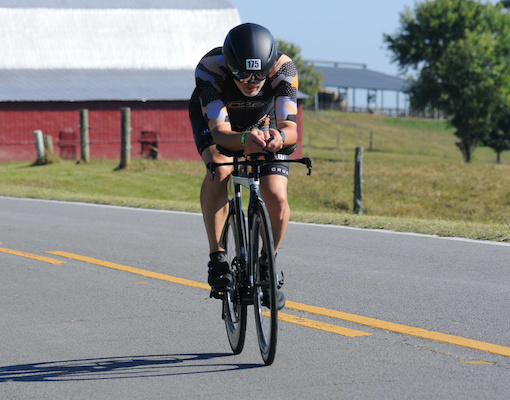
T2
My transition from bike to run went very smoothly. Having grabbed my run bag, I went to the change tent, put on my run gear and left. I carried a disposable water bottle and a banana with me as I ran to the start of the run course. That banana was fantastic. It really settled my stomach down and I plan to eat one coming out of T2 in my future races.
T2 Time : 0:05:23
The Run
It was time to find out if my legs would hold up on the run. Just after leaving transition, I saw my wife. She was smiling and knew that I would be happy with my bike split time. I told her about my muscle issues and probably sounded grumpy about it. As ever however, she shouted encouraging words and I went on my way.
Within the first mile out of transition, there is quite a climb. Halfway up this hill, I saw my coach. He too looked happy and asked how I was feeling. I told him I was struggling with muscles spasms, so he said to start out steady. He then told me that I was less than five minutes behind the athlete who currently in the final podium spot for my age group. That news really encouraged me. I had no idea I was doing that well.
Despite my concern about my legs, I discovered that I could run at a nice steady pace. I grabbed water ate the first two aid stations and took in a couple of energy chews. At the third station, I chose to take a little more time. I drank some coke and took on board some ice. I put some ice into my kit and carried some in my hands. Carrying ice in your hands really helps keep the core temperature down and I found that once again this was indeed true.
Having run along the highway for almost four miles, I made the turn onto the Riverwalk and headed back to town. This section of the course is nice to run. It is very flat and a great deal of it is in shade. I was able to continue running quite well and eventually made it to Battery Place hill.
As it turned out, I had left T2 in ninth place in my age group. By the time I got to battery hill, I had already gained a place and was now in eighth. This is the highest I have ever been in my age group during a race. I had been struggling with muscle spasms for hours and was still in with a shot at a podium spot.
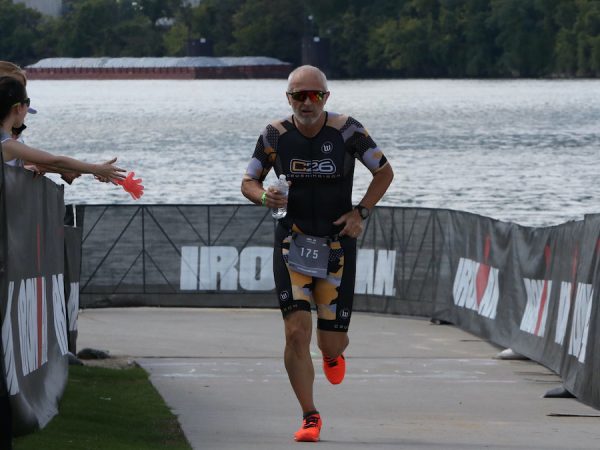
Battery Place hill is not a long climb, but it is quite steep. It comes as a little bit of a shock to the system after a couple of miles on the Riverwalk. As I approached the climb, I could see a teammate ahead of me and some friends who were supporting. I began to run up the hill and then, about ten steps in, my right leg completely locked up with cramps. I mean completely locked up. I came to a dead stop. My heart sank.
I managed to stretch out the cramp in my leg and started walking up the hill. It was a slow walk up the hill, but thankfully I had the support of my friends to get me focused on moving forward. I stopped at the aid station at the top of the hill to pull myself together and take on board some electrolytes. Would I be able to run without cramping? I still had just under eighteen miles to go. I had no choice but to try.
I started running and surprisingly felt quite good. I ran down the little hill and turned sharp right onto the Veteran’s Bridge. As I turned onto the bridge, I immediately saw my wife. Seeing her gave me a huge boost. I made it over the bridge without any more issues, but ahead of me lay the notorious Barton Avenue climb. With some trepidation, I started to run up it. Sure enough, I soon felt my leg starting to cramp up again. I slowed to a walk and that is how I went up the rest of the hill.
Once at the top, I started running again. Running downhill was fine and I was also able to run up the less steep hill of Hixson Pike. I concluded that walking up steep hills and running the remainder of the course was now my only option. Mentally, this was tough. I knew that I had a great time there for the taking and now it was gone.
As I ended the loop around Riverview Road by the country club, another issue struck. Major stomach cramps. These too, stopped me in my tracks. I thought to myself, what else could go wrong? As I came around the corner, I saw an aid station and some porta johns. Maybe a bathroom break would fix my stomach. I tried and the pain eased enough to carry on.
Through a combination of running and walking, I eventually made it to the end of the pedestrian bridge. I knew my wife, my coach and a lot of friends would be there. It was great to see them, and together with the fact that I was halfway through the marathon, I was once again boosted to carry on. At this point, I was confident I could finish the race. I just knew it would be tough and that my run time wouldn’t be the greatest.
Once on the second loop, I continued my run walk strategy. My only thoughts were… the faster I can run, the sooner the pain I was in would be over. I was hurting badly, and I just wanted it to end. This was a fascinating motivator. Endure more pain to get it to end earlier.
The first half of the second loop was a bit of a blur. I was convinced that today was going to result in my worst Ironman performance so far. I was ‘running’ so slowly. As I ran up Hixson Pike for the second time, I happened to glance at my watch. I had long ago turned off the workout because I didn’t like being reminded of my pace. The only display on my watch was the time of day and it said 7.11pm. I double checked. Yes, it was only just after seven o’clock. I distinctly remembered getting into the water at the start of the race at almost exactly 8.00am. Holy smokes… if I could finish before 8.00pm, then I would achieve a sub-12 hour Ironman, a huge PR.
I did some quick math in my head and realized that I needed to run under 15-minute miles to get in under twelve hours. That seemed highly possible and was all the boost I needed to double down on embracing the pain. The big barrier was the one last time up Barton Avenue. I got to the bottom and started walking up. I walked much faster than before, pumping my arms vigorously. Swinging my arms seemed to help and before I knew it, I was over the top of the hill and running. I was going to make that sub-12-hour time!
I ran down Barton Avenue for the final time. I blasted past the final last aid station. Over the pedestrian bridge to see my wife and friends again. I made the left hand turn towards the finish line and I was now running quite fast. The pain was significant, but the noise from the finish line was calling me. The red carpet appeared, and I ran into the bright lights of the finish line. I crossed the line and looked at my watch …. 7.53pm. I had done it…
Run Time : 4:53:30
Overall Time : 11:50:23 (18th in age group)
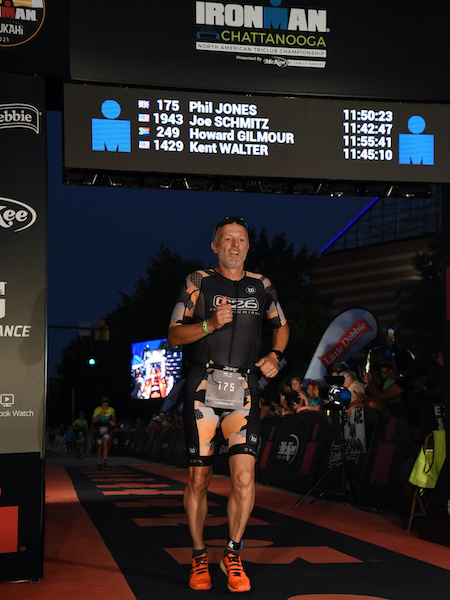
Post-Race
Once over the finish line, I was greeted by a volunteer with my finisher cap, medal and T-shirt. My legs were really painful and even walking was tough. I made my way through to where I could see my wife and went over to see her. I wasn’t feeling too good. I was feeling drained and could feel blood coursing through my veins. After a few minutes, I mentioned to my wife that maybe I should get some medical help, but she was already ahead of me. She had called over one of the medical volunteers and they were right there, when I mentioned I needed help.
The volunteers got me to lie down and then over the course of about twenty minutes, they got me sorted out. A combination of sipping on Gatorade and some gentle muscle stretches was all I needed. I was then, with the help of my wife, able to get my bike and gear from transition and slowly walk back to hotel. Once there, I went straight to bed, snacked on some food and went to sleep. My day was over.
The next day, when I thought about my race, I was frustrated by the fact that I came so close to my dream of a podium slot. This frustration lasted for a few days, but eventually in the cold light of day, I realized what a great race I had. My first ever sub-12 hour Ironman and PR’s for both the swim and bike legs. I had continued with my trend of getting faster as I get older.
Physical recovery from this race was tough. I had sore quads, feet and knees. It took almost two weeks before my legs felt good enough to run again. This was by far the longest recovery period of my short triathlon career.
Lessons Learned
In looking back on this race, I see two areas where I need to improve. I must figure out why I cramped so much, and I also need to revisit my nutrition plan.
My best guess as to why I cramped so much in my adductors, is that they were simply not strong enough. They are not muscles that I have focused on within strength work, and this is what I will change moving forward.
The stomach cramping during this race was unusual for me. I have not experienced that before. I think my nutrition plan on the run went awry. When I started cramping, I lost focus, stopped taking my energy chews and switched to just drinking Coke. I suspect my stomach eventually disliked all that Coke. Sticking with just Coke, also likely changed my electrolyte balance. I was probably deficient by the end of the race and that is probably why I needed that medical help.
As always, there are things to learn from every race. Even when you have a PR, there are always opportunities to improve.